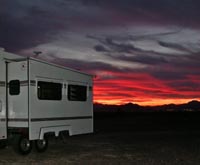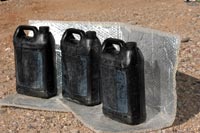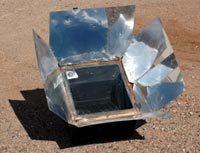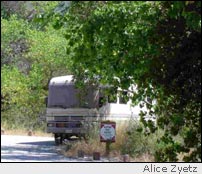| The
Wilderness Experience...In An RV! Boondocking Etiquette by Jaimie Hall |
|
"Boondocking" means camping in your RV with no hookups. There are two types of boondocking. One type is parking in more out-of-the-way places, usually for several days or even an extended period of time. Public lands offer many opportunities for boondocking.
The other type of boondocking is often referred to as "blacktop boondocking," that is when you camp overnight on a Wal-Mart or shopping center parking lot or in a truck stop. Some call it dry camping since you are not in the "boonies." RVers choose to spend the night on parking lots because of convenience-they don't have to drive miles off the highway to a campground. Other RVers boondock because of budget reasons; they can't see paying $20 or more a night to stay in an RV park when they are traveling from point A to point B and won't be using the amenities the park has to offer. Whichever type of boondocker you are, these guidelines will help you (and your neighbors) have a better experience.
BLACKTOP BOONDOCKING
- Get permission from the manager.
- Purchase dinner, fuel or other items as a thank you.
- Park away from other vehicles, along the sides of the parking lot. In a truck stop, if there is no designated area for RVs, park off to the side or to the back away from truckers. Truckers will appreciate you not taking their spaces, plus it will be less noisy for you.
- Do not get chairs and barbeque out, nor put out your awning. Avoid using your slideouts if possible.
- Stay only one night.
- Pick up any trash you have generated.
- Because boondocking on Wal-Mart's parking lot is a hot issue in many towns, following these simple rules will help keep these places open to travelers who want a night's sleep before moving on. Disregarding them, especially making your area look like you've moved in for a lengthy stay, is what gets local RV park owners up in arms. They see RVs in a Wal-Mart or other parking lot as revenue they should have had. Escapees RV Club provides Boondocking Etiquette cards you can download and then leave on an individual's windshield who is not following these guidelines and jeopardizing the rights of other RV travelers as well.
BOONDOCKING IN THE "BOONIES"
When we think of regular boondocking, we think more of camping in wilderness areas, often on public lands. Campgrounds in public lands generally do not provide hookups. The USDA Forest Service and Bureau of Land Management (BLM) also allow camping outside their designated campgrounds. In some places, it is called "dispersed camping."
Serious boondockers modify their RVs so they can take advantage of free camping in pretty places. Solar panels and an inverter keep batteries charged. A catalytic or ceramic heater is more efficient than the regular RV heater and doesn't draw down the battery. Boondockers may have a Blue Boy®, a portable waste holding tank, so they can take blackwater into a dump. They carry water jugs to haul water to their fresh water tank. Boondockers learn how to conserve both power and water so they can extend their stays and may even use solar ovens for cooking and heat water with the sun. (To learn more about how to boondock effectively, see "Boondocking Basics" by Paul Bernhagen on this page from the Inland NW Airstream Club.)
Most campers are here for a wilderness experience; they enjoy the peace and quiet. Following these guidelines will help all enjoy their stay as well as protect the environment.
- Park in previously used areas. Do not create a new road or parking spot or run over vegetation.
- Park away from other RVs so each can enjoy the peace and quiet. If you do have a generator you plan to run, park far away from other RVs and limit your use to an hour or so in the morning and another in early evening. Generator noise carries and is not part of the wilderness experience.
- Respect quiet hours. Do not run generators or play TVs or radios loudly after 10 p.m. or before 7 a.m. (Some areas may have different quiet hours so check with the agency.)
- In some areas dumping grey water on the ground is permissible. Always check with the agency first. Dumping black water on the ground is never permitted.
- Leave the area cleaner than you found it. Dispose of trash in a trash container after you leave.
- Read and follow the agency's rules regarding fires, collecting firewood, and quiet hours. Respect time limits, which are typically 14 days.
RV groups meeting on public lands should choose an area large enough to accommodate their group without damaging the environment and should respect the rights of nearby campers that are not part of the group. They should also educate their members, who may never have boondocked before, on ways to extend their battery power without constantly running their generators and on ways to conserve water.
For many RVers, boondocking is the true RV experience.
The ability to camp without hookups is one of the advantages
of RV ownership; you can camp free of charge and use the systems
that were designed to be self-contained. Using courtesy and
common sense can make your boondocking experience-whether
on blacktop or in the wilderness-a good one for you and other
RVers.
Jaimie Hall-Bruzenak
4/1/07
(Links updated 12/6/21, RTA)




